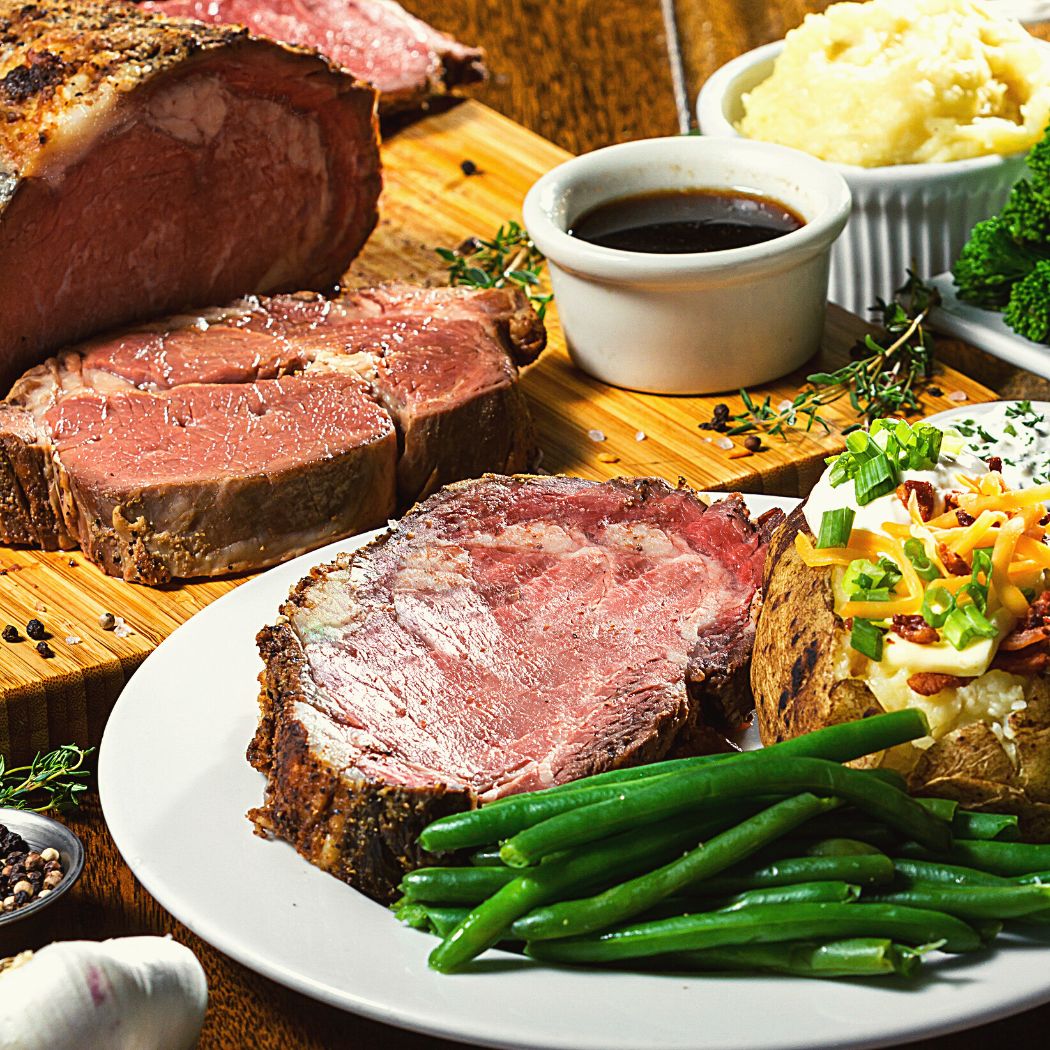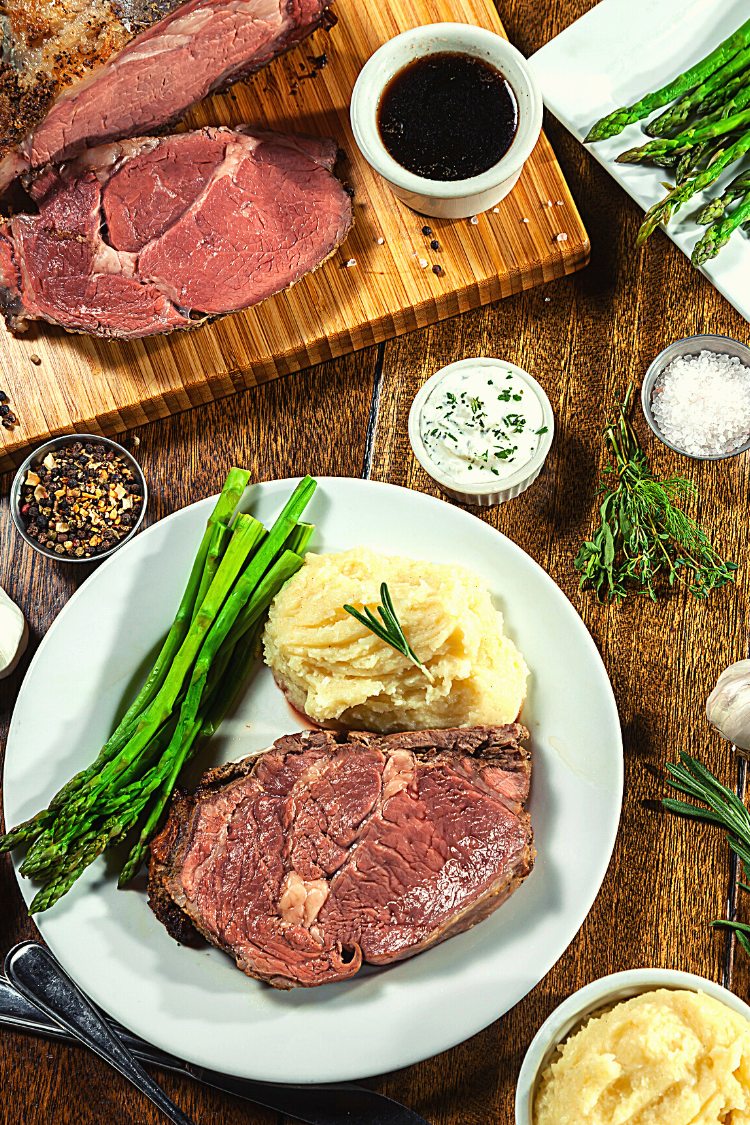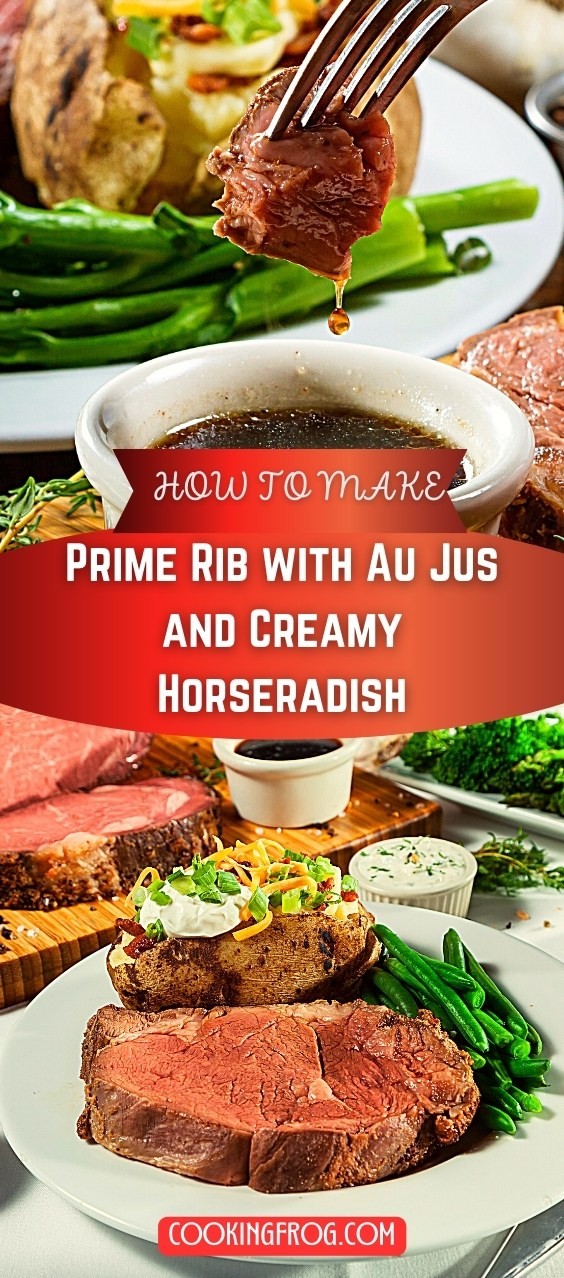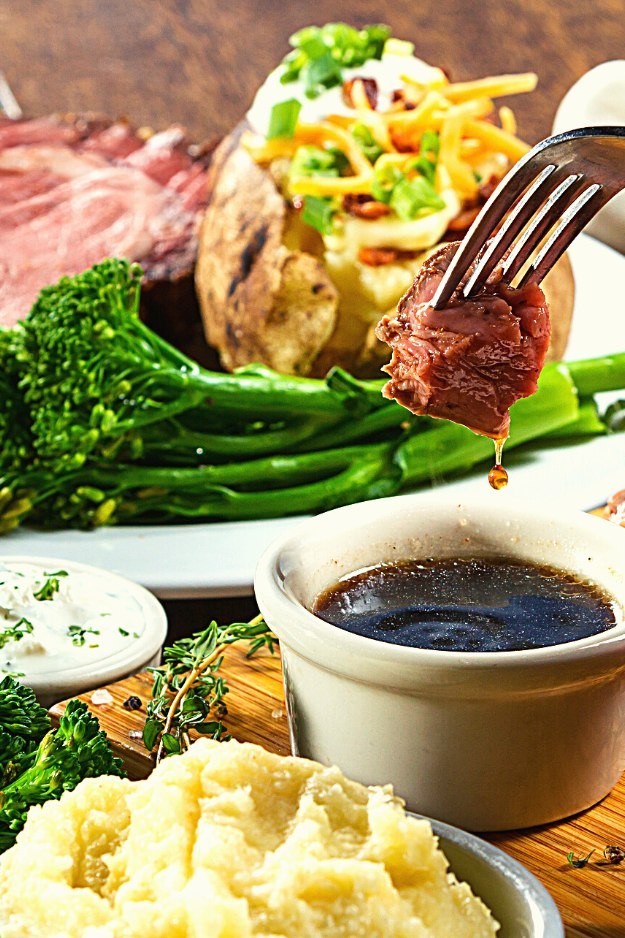Prepare to amaze your guests this holiday season with our succulent prime rib recipe, finished with a rich au jus and a tangy and creamy horseradish. And for folks who choose a wine-free option, we’ve got you covered with an equally flavorful au jus alternative.
This isn’t just a recipe; it’s the secret to a tender, medium-rare roast that’s exploding with flavor. This prime rib is surprisingly straightforward to make and excellent for Christmas or any festive gathering. With its delectable assortment of classic flavors and clear steps, it’s set to become a holiday favorite.
Why This Prime Rib Recipe Stands Out!
Efficiency at Its Finest: With just a 5-minute prep time, this prime rib recipe is both quick and straightforward, ensuring you spend a shorter amount of time in your kitchen and more with your family and guests without compromising a great meal.
Burst of Flavors: Our tangy horseradish cream and decadent au jus are meticulously prepared to complete the juicy prime rib, enhancing each bite.
Wine-Free Option: Acknowledging diverse choices, we’ve included an equally delicious wine-free au jus option, ensuring everyone’s palate is catered to.
Perfect for Holidays and Large Gatherings: This recipe isn’t just about flavor; it’s about abundance as well. Serve a gathering and watch the praises flow. Any leftovers can be converted into gourmet sandwiches like this Arby’s beef and cheddar, offering a comforting next-day treat.
Simplicity is Critical: Our step-by-step guide ensures a bother-free culinary adventure. There’s no necessity for extensive planning or cooking expertise; just follow along and appreciate the results.
Ingredients
For the Prime Rib
-
1 prime rib roast (about 6–7 lbs)
-
¼ cup unsalted butter, softened
-
2 cloves garlic, minced
-
1 Tbsp fresh rosemary, minced
-
1 pinch ground sage
-
Sea salt, to taste
-
Freshly cracked black pepper, to taste
For the Au Jus
-
¼ cup butter or beef drippings from the roast
-
2 Tbsp all-purpose flour
-
¼ cup red wine (Cabernet Sauvignon or your favorite; see notes for wine-free options)
-
2 cups beef broth, divided
-
1 Tbsp Worcestershire sauce
-
Salt and freshly cracked black pepper, to taste
For the Horseradish Cream
-
8 oz sour cream
-
½ cup mayonnaise
-
1 Tbsp finely chopped scallions
-
3–4 tsp prepared horseradish (adjust to your spice level)
-
1 Tbsp fresh dill, chopped
-
2 tsp Dijon mustard
-
2 tsp white wine vinegar
-
¼ tsp sea salt
Instructions
1. Make the horseradish cream
In a medium bowl, mix together sour cream, mayonnaise, scallions, horseradish, dill, Dijon, vinegar, and salt. Cover and refrigerate for at least 1 hour, or overnight for deeper flavor.
2. Prep the roast
-
Preheat your oven to 450°F (230°C).
-
In a small bowl, mix softened butter, garlic, rosemary, and sage.
-
Pat the prime rib dry with paper towels. Season generously with salt and black pepper. Rub the garlic-herb butter mixture evenly over the roast. (If you prefer a simpler crust, just use plain butter and season generously with salt and pepper.)
3. Roast the prime rib
-
Place the roast in a roasting pan, fat side up.
-
Roast at 450°F (230°C) for 15 minutes to create a crust.
-
Lower the oven temperature to 325°F (165°C) and continue roasting until the internal temperature reaches:
-
120°F (49°C) for rare
-
125–130°F (52–54°C) for medium-rare
-
-
Baste the roast with pan drippings every 30 minutes for extra flavor.
4. Rest the roast
Transfer the roast to a cutting board, tent loosely with foil, and let it rest for at least 20 minutes. This allows the juices to redistribute for tender, juicy slices.
5. Make the au jus
-
In a saucepan over medium heat, melt the butter or use ¼ cup of beef drippings from the pan.
-
Whisk in the flour to form a smooth paste and cook for about 1 minute.
-
Slowly add the red wine, whisking until the alcohol smell dissipates.
-
Gradually whisk in ½ cup of beef broth until smooth, then add the remaining broth and Worcestershire sauce.
-
Bring to a boil, then reduce heat and simmer for 5–7 minutes until slightly thickened. Season with salt and pepper to taste.
6. Serve
Slice the prime rib against the grain. Serve with a drizzle of au jus and a dollop of creamy horseradish sauce on the side.
Tips for Success
-
Use a meat thermometer — it’s the best way to get perfectly cooked prime rib.
-
Letting the roast rest is essential to keep it juicy.
-
Make the horseradish cream a day ahead for a stronger, more developed flavor.
-
For a wine-free au jus, swap the wine for extra beef broth and add a splash of balsamic vinegar for depth.
Storage & Reheating
-
Refrigerator: Store leftovers in an airtight container for up to 4 days.
-
Freezer: Wrap tightly and freeze for up to 2 months.
-
Reheat: Warm gently in the oven at 250°F (120°C) or in a skillet with a splash of beef broth to keep the meat tender.
Au Jus Wine-Free Options
Good Ol’ Broth: Whether it’s beef broth, chicken, or veggie broth, it is an excellent replacement for wine in this recipe. It deepens the meaty essence without a hint of alcohol.
Apple Cider: For a hint of fruity zest, apple cider or its gentler cousin. If it feels a bit sweet, a dash of vinegar or a squeeze of lemon can counterbalance things.
Grape Juice Twist: Often praised as the non-alcoholic twin of red wine, grape juice can fill in adequately. Mix in a splash of vinegar for every cup you use to seize the wine’s tang.
Cranberry’s Tart: Particularly when you’re skipping red wine, cranberry juice, with its natural tartness, can be a satisfying alternative.
Tomato’s Tangy Note: Its natural acidity makes tomato juice a convenient replacement, adding a unique depth to the blend.
A Vinegar-Broth Blend: While wine vinegar infuses more tang than standard wine, combining it with broth (add 3:1 in favor of broth) can get you pretty close to the authentic flavor.
Lemon’s Zesty Punch: A bit of lemon juice can add the sharpness often brought by wine, especially in small amounts.
Plain Water: It might sound plain, but in a tight spot, water can help keep the recipe’s consistency, even if it’s a tad less delicious.
Prime Rib Au Jus Tips for the Best Results:
- Horseradish Cream: Use freshly grated horseradish in your sauce for an even richer taste. The spice and freshness can boost the sauce to new heights.
- Seasoning Secrets: When seasoning your roast, make sure you’re using coarse salt and freshly cracked black pepper. The consistency and flavor they impart are outstanding.
- Butter Shine: If you use butter for the roast, always go unsalted. This offers you complete control over the saltiness of your dish.
- Thermometer Tips: Always have a good-quality meat thermometer at hand. It’s the most trustworthy way to guarantee your roast is perfectly cooked. Remember to insert it into the thickest part of your roast, bypassing any bones.
- Resting Importance: Never neglect the resting stage for your roast! This lets the juices redistribute, making every slice juicy and mouthwatering.
- Au Jus Adjustments: If your au jus is too thick, you can always thin it with more beef broth. Conversely, a quick simmer can help reduce and thicken it if it’s excessively thin.
- Wine Understanding: When preparing the delicious au jus, always use a wine you’d enjoy consuming. The grade of the wine can greatly impact the flavor of the sauce.
- Herb Hints: Fresh herbs can make a lot of difference to the taste of your roast. If you’re using the garlic-rosemary and sage crust, ensure your rosemary is fresh and finely chopped for the best fragrance and taste.
- Serving Suggestions: Consider warming the plates slightly before serving your prime rib. This keeps the meat warm and improves the overall dining experience.
- Leftover Love: Prime rib leftovers can be converted into mouthwatering sandwiches, salads, or stir-fries. Don’t let any of the prime rib goodness go to waste!





